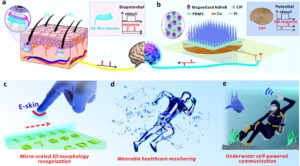A research team led by Zhou Bingpu, an associate professor at the Institute of Applied Physics and Materials Engineering (IAPME), University of Macau (UM), has designed a self-powered and multifunctional electronic skin (e-skin) that can not only mimic human skin in terms of tactile perception, but is also capable of quantitative recognition of 3D surface information. With its high-capacity communication capability, the e-skin is expected to be applied in various scenarios, such as real-time health monitoring, recognition and reconstruction of micro-scaled topography, and underwater communication. The research results have been published in Advanced Functional Materials, a leading international journal in the field.
As electronic devices that mimic human skin, e-skins are expected to have similar sensory functions, including tactile perception and the ability to interact with the environment. Although most of the e-skins today are capable of sensing tactile intensity or pressure, quantitative recognition of 3D surface morphology remains a challenge for them. Furthermore, it is desirable that e-skins can generate commands in response to different mechanical stimuli and work stably in different environments.
Inspired by human skin, the research team has designed a flexible e-skin consisting of a whisker-like magnetised micro-cilia array (MMCA) and flexible coils. With the built-in alignment of magnetic moments, the mechanical stimuli-induced MMCA deformation can generate related voltage signals within the coils to provide feedback for reflecting the external pressure and surface morphology. The study systematically investigated the relationship between the induced voltage and pressure, and optimised the MMCA to ensure a reliable voltage profile that can quantitatively reflect the 3D information of the surface morphology. By customising the alignment of magnetic moments, the e-skin can further output multiple voltage waveforms as information codes on one device for efficient human-machine interaction and high-capacity transmission. As the perception capability of the e-skin is originated from the electromagnetic response, the e-skin is self-powered and can work stably in harsh conditions such as high temperature or underwater. The study comprehensively shows the strengths of the e-skin in different applications, such as real-time health monitoring (including the recognition of breath status and joint bending), Braille identification, reconstruction of relief information, high-capacity command transmission, and Morse code communication underwater.
The corresponding author of this study is Prof Zhou, and the first author is Zhou Qian, a PhD student at IAPME. The project was funded by the Science and Technology Development Fund, Macao SAR (File no: 0088/2021/A2 and 0026/2020/AGJ) and the Department of Science and Technology of Guangdong Province (2021A0505080004). The full version of the paper can be viewed at https://onlinelibrary.wiley.com/doi/10.1002/adfm.202208120
澳門大學應用物理及材料工程研究院副教授周冰樸的研究團隊設計出一種自供電的多功能柔性電子皮膚,不僅具有類似於人體皮膚的觸覺感知能力,還可定量識別並反饋表面的三維形貌信息。該電子皮膚兼具大容量信息交互能力,有望應用於穿戴式健康監測、微觀形貌的識別與重塑、水下智能通信等不同領域。該研究成果已獲國際知名學術期刊《先進功能材料》(Advanced Functional Materials)刊登。
作爲模仿人體皮膚的電子器件,人們希望柔性電子皮膚具有與皮膚類似的感知功能及與外界交互的能力。目前,雖然已報道的大部分柔性電子皮膚能夠實現對觸覺強度(即壓力)的感知,但在對三維微觀表面形貌的定量識別仍是一個挑戰。另外,柔性電子皮膚是否能因應不同機械輸入而生成多種指令,且可在不同環境場景下穩定工作,也是智能化時代對柔性電子皮膚所提出的新要求。
受人體皮膚的啓發,研究團隊設計出由毛髮狀磁化微纖毛陣列(MMCA)和柔性綫圈組成的電子皮膚系統。得益於MMCA内置的對齊磁矩,外界機械刺激所帶來的的微纖毛形變能夠在導電線圈中產生相應的電壓信號,從而實現對外部壓力及表面形貌的反饋。該工作系統研究了電壓強度與壓力的內在聯繫,並探討如何設計MMCA以優化電壓信號的强度和波形來定量反饋表面形貌的三維信息。此外,通過調控MMCA内置的磁矩排列,該電子皮膚亦可在單一器件上輸出多種電壓波形作爲信息編碼,用於高效人機交互和大容量信息傳輸。由於該電子皮膚的工作原理是電磁感應現象,因而能在高溫、水下等不同環境中以自供電的方式實現穩定工作。相關論文綜合展示了該電子皮膚在穿戴式健康檢測(包括呼吸狀態、關節彎曲感知等)、盲文識別與浮雕信息重塑、大容量指令傳輸、水下摩斯密碼通信等多方面的應用優勢。
該項研究的通訊作者為周冰樸,論文的第一作者為澳門大學應用物理及材料工程研究院博士生周倩。此項研究由澳門特別行政區科學技術發展基金(檔案編號:0088/2021/A2和0026/2020/AGJ)和廣東省科學技術廳(檔案編號:2021A0505080004)資助。全文可瀏覽: https://onlinelibrary.wiley.com/doi/10.1002/adfm.202208120
ZHOU Bingpu (4th from left) and ZHOU Qian (3rd from left)
(左四) 周冰樸 和 (左三) 周倩
A schematic diagram of human skin(a),
and the magnetised multifunctional e-skin(b);
applications of the e-skin for 3D surface morphology recognition(c),
real-time health monitor (d),
underwater self-powered communication (e)
a) 人體皮膚及 b) 磁化多功能電子皮膚的結構示意圖;
柔性電子皮膚的 c)三維形貌識別、
d) 穿戴式健康監測及 e) 水下信息交互示意圖



